Purgatory River Campground
One of the reasons that my husband and I purchased land in southern Colorado was because of the many trail riding opportunities in the area, but for the last ten years, all of our camping and riding had been done on or near our little “ranch.” Now that we have become permanent residents and have completed many of our must-do jobs, we made a resolution to renew the horse camping trips that we had enjoyed years earlier in Nebraska, Wyoming, Iowa, Colorado, and Kansas. We decided for our first adventure to camp close to home, so chose the Purgatory River Campground on the edge of the North Lake State Wildlife Area in the Sangre de Cristo Mountains that we can see from our deck.
After visiting the campground near Cuchara Pass in Colorado and checking out the facilities, we made reservations for three nights at campsite #8, the only one that would accommodate our 35 foot trailer. We were pleased with how easy the process was, even after we had to cancel and rebook a couple of times. We had also walked up the Purgatory River Trail a ways, talked to the camp host who had said that some young men had ridden the trail to the top the week before, and were assured by a ranger for the area that the main trail had several pack trails that led to hunting camps that we could also explore.
Since we have not camped with the horses for over five years, getting organized for the trip took several days, for we had to gather the hay bags, extra buckets, portable fence, and high line materials as well as pack the certified hay required for the federal site, grain, and supplements. We took along our rain gear, both for us and the horses, since Colorado has been going through a rainy spell, and July begins the monsoon season here. Then there were the sport boots to protect the horses’ pasterns in rough terrain and extra bridles in case one broke (which we remembered from past experience). We also threw in our chinks for good measure. Saddles, bridles, halters, and blankets rounded out the supply list. Oh yes, the fly and mosquito sprays for everyone involved, citronella candles to ward away mosquitoes, food for the dog, and the emergency first aid supplies (bandages, wraps, Furazone, Bute, and Banamine) for the horses. Then we had to stock the camper with food, toiletries, and clothing as well as clean the camper and vacuum up the dead flies and miller moths.
Meanwhile, my husband, checked the tires, packed the wheel bearings, made sure the generator and miscellaneous accessories were properly working, and loaded the chain saw, weed eater (since our horse are kept in a dry lot and the campsite was belly deep in lush grass to which they were not accustomed), and hatchets. The camp host told us that we could cut and split any of the dead wood around the campsite, so we did not have to haul our own for the campfires we planned on enjoying. “What an ordeal,” we thought, but assured ourselves that it would be easier the next time around.
 On the Monday morning of June 29, 2015, we loaded up the horses and dog and headed down the mountain to I-25. We decided to take the longer route south through Trinidad and then north up the Highway of Legends (State Highway 12) to avoid the steep, curving climb over Cuchara Pass that we would have encountered if we had gone north through La Veta and Cuchara and then south. After a short two hours, we arrived at Monument Lake and turned west toward the campground. The four miles of dirt road to the campsite was recently maintained, and the campsite was easy to access and back into. The friendly camp host, David, even came to help us out.
On the Monday morning of June 29, 2015, we loaded up the horses and dog and headed down the mountain to I-25. We decided to take the longer route south through Trinidad and then north up the Highway of Legends (State Highway 12) to avoid the steep, curving climb over Cuchara Pass that we would have encountered if we had gone north through La Veta and Cuchara and then south. After a short two hours, we arrived at Monument Lake and turned west toward the campground. The four miles of dirt road to the campsite was recently maintained, and the campsite was easy to access and back into. The friendly camp host, David, even came to help us out.
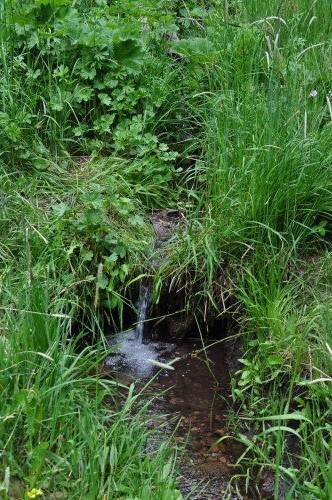 The campsite was awesome! Two large aspen trees worked well to string the high line between, and after my husband trimmed the grass under it, we tied up the horses. They had never been tethered to a High Line before, but we had practiced at home, so they handled that well, especially after we gave them some hay to keep them busy while we set up our own campsite. A spring-fed creek bubbled nearby, and we took the horses to it to give them a drink. However, they were more excited about the grass, so we had to bucket the water to them the remainder of the stay. However, there was a little waterfall, and filling the buckets was quick and easy.
The campsite was awesome! Two large aspen trees worked well to string the high line between, and after my husband trimmed the grass under it, we tied up the horses. They had never been tethered to a High Line before, but we had practiced at home, so they handled that well, especially after we gave them some hay to keep them busy while we set up our own campsite. A spring-fed creek bubbled nearby, and we took the horses to it to give them a drink. However, they were more excited about the grass, so we had to bucket the water to them the remainder of the stay. However, there was a little waterfall, and filling the buckets was quick and easy.
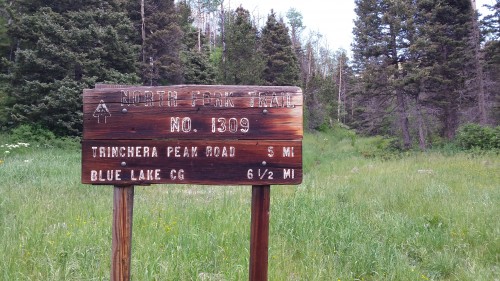 Since we had arrived at the campground around eleven o’clock, we had plenty of afternoon to begin trail riding. We decided to try the main trail, the North Fork Trailhead (#1309), that followed the Purgatory River toward its headwaters.
Since we had arrived at the campground around eleven o’clock, we had plenty of afternoon to begin trail riding. We decided to try the main trail, the North Fork Trailhead (#1309), that followed the Purgatory River toward its headwaters.
The weather was perfect, sunny with a cool breeze, and although the rushing, whitewater of the Purgatory River right beside the trail was a new sound to our horses, they soon became accustomed to it.  We had to cross a spring-fed rivulet that my husband’s young mare jumped across, and we continued on our way, admiring the wildflowers, aspens, and fir trees lining the trail. About a quarter of a mile up the trail, the path started becoming very rocky. Our horses are used to riding over and around rocks and boulders, but these rocks were jagged, large, unstable, and so prevalent that they had trouble finding secure footing.
We had to cross a spring-fed rivulet that my husband’s young mare jumped across, and we continued on our way, admiring the wildflowers, aspens, and fir trees lining the trail. About a quarter of a mile up the trail, the path started becoming very rocky. Our horses are used to riding over and around rocks and boulders, but these rocks were jagged, large, unstable, and so prevalent that they had trouble finding secure footing.
However, they trudged gamely on until we came to a wider stream crossing with more large rocks, branches, and logs to 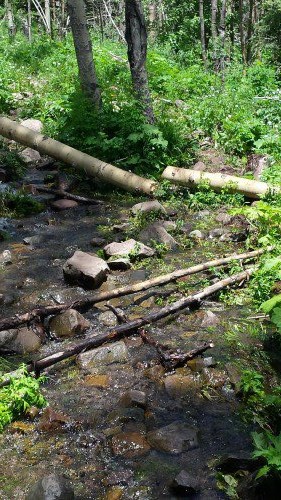 navigate. My fifteen-year old gelding, JJ, was willing to give it a try, but my husband’s young mare, Jacki, on this her first trail ride away from home, insisted that no way would she cross that creek. After considering the slippery rocks, mud, and other obstacles, we decided that it might be wiser to turn back than figure out how to summon help with no cell signal. Besides, the trail continued on, still full of rocks. We decided that the young men who rode earlier to Trinchera Peak must have had REAL trail horses, or else they were young and felt invincible.
navigate. My fifteen-year old gelding, JJ, was willing to give it a try, but my husband’s young mare, Jacki, on this her first trail ride away from home, insisted that no way would she cross that creek. After considering the slippery rocks, mud, and other obstacles, we decided that it might be wiser to turn back than figure out how to summon help with no cell signal. Besides, the trail continued on, still full of rocks. We decided that the young men who rode earlier to Trinchera Peak must have had REAL trail horses, or else they were young and felt invincible.
We turned around and headed back to camp–the horses relieved and the dog disappointed. We spent the rest of the afternoon enjoying the campsite, my husband cutting and splitting some logs and kindling for the fire while I fed and watered the animals and cleaned up after the horses. For supper, we grilled some pork chops and smoked brauts over the fire in our new cast iron skillet and dined on the picnic table. A full moon lit up the valley, and we spent the evening watching the horses, listening to the gurgling stream and the rustling of the aspen, and imbibing in some spirited drinks.
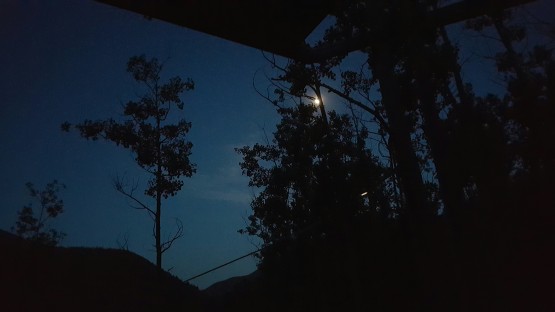 The coolness of the night necessitated a goose down blanket. Yet as warm and comfy as I was, I worried all night about the horses in the new environment. I knew Bear, our dog, would warn us of any bears, coyotes, or cougars, but how the horses would cope with being tied up all night concerned me, so I slept with the proverbial one eye open, checking out the window of the gooseneck throughout the night, the moonlight making a flashlight unnecessary. My wariness was fortunate because about three o’clock, I noticed that the mare was loose, contentedly grazing on grass. She had turned around so many times that the panic snap must have twisted loose. After securing her and snuggling back under the blanket, I awoke again a couple of hours later to find my gelding following her example, his quick release snap now unfastened. Fortunately, neither of the horses would have wandered far without the other, and although we are hesitant to forgo the safety snaps, we will have to rethink the high line ties.
The coolness of the night necessitated a goose down blanket. Yet as warm and comfy as I was, I worried all night about the horses in the new environment. I knew Bear, our dog, would warn us of any bears, coyotes, or cougars, but how the horses would cope with being tied up all night concerned me, so I slept with the proverbial one eye open, checking out the window of the gooseneck throughout the night, the moonlight making a flashlight unnecessary. My wariness was fortunate because about three o’clock, I noticed that the mare was loose, contentedly grazing on grass. She had turned around so many times that the panic snap must have twisted loose. After securing her and snuggling back under the blanket, I awoke again a couple of hours later to find my gelding following her example, his quick release snap now unfastened. Fortunately, neither of the horses would have wandered far without the other, and although we are hesitant to forgo the safety snaps, we will have to rethink the high line ties.
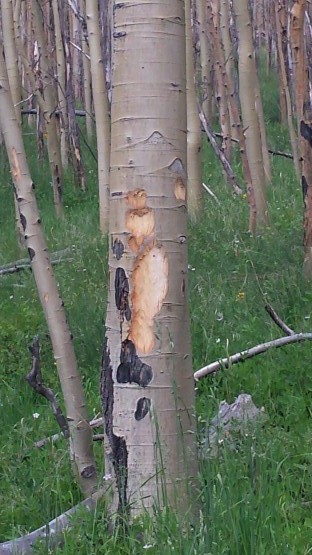 Some off our neighbors had interested my husband in trout fishing , so he was anxious to try his luck on a pond that he discovered on Google Maps about a third of a mile north of our campsite, so after feeding the horses their breakfast, we decided to hike up to it. We found several landmarks he had seen on the map, so we were encouraged. However, what we did not reckon on was that the ascent was basically vertical with deadfall slowing our climb. The fallen trees looked like the Pick-Up-Sticks game that we used to play together as children. The wildflowers and berry bushes were gorgeous, and we even noticed some fresh bark missing on the aspen trees and decided that the elk must have fed on the trees over the winter. We always wondered why aspen trees always look so scarred! Finally, we gave up when we reached yet another ridge with no trout pond in sight. Even if we had found it, we decided, climbing back up with fishing gear would not be worth it.
Some off our neighbors had interested my husband in trout fishing , so he was anxious to try his luck on a pond that he discovered on Google Maps about a third of a mile north of our campsite, so after feeding the horses their breakfast, we decided to hike up to it. We found several landmarks he had seen on the map, so we were encouraged. However, what we did not reckon on was that the ascent was basically vertical with deadfall slowing our climb. The fallen trees looked like the Pick-Up-Sticks game that we used to play together as children. The wildflowers and berry bushes were gorgeous, and we even noticed some fresh bark missing on the aspen trees and decided that the elk must have fed on the trees over the winter. We always wondered why aspen trees always look so scarred! Finally, we gave up when we reached yet another ridge with no trout pond in sight. Even if we had found it, we decided, climbing back up with fishing gear would not be worth it.
When we returned to camp, we found the horses covered with flies, even though we had sprayed them thoroughly before we left. So, we tried a different brand of spray. Unfortunately, the flies must have considered it a tasty condiment.
After a short rest, we saddled up and headed for the only other trail 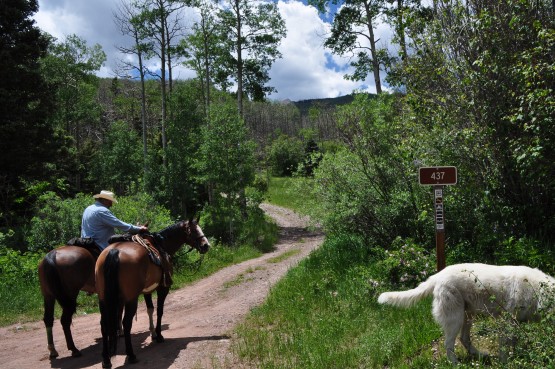 near the campground, Road 437, a jeep road that leads to the top of Maxwell Peak. The 3.2 mile trail is steep. It starts at 9,700 feet and the summit rises to 13, 335 feet. The road is rocky and full of switchbacks, but it is very rideable, especially when we took some stops to give everyone a breather. The scenery was amazing, mostly aspen and some fir trees, thick mountain grasses, blankets of wildflowers, and a creek clamboring below us. Bear was enamoured by the creek, especially after the long climb, but I held my breath a little when he first climbed in to drink and cool off. The current was so swift that I was afraid it would wash him down to where he could not climb to firm ground. I should not have worried, for he found a safe place and lay in the rushing water until he was ready to resume our ascent.
near the campground, Road 437, a jeep road that leads to the top of Maxwell Peak. The 3.2 mile trail is steep. It starts at 9,700 feet and the summit rises to 13, 335 feet. The road is rocky and full of switchbacks, but it is very rideable, especially when we took some stops to give everyone a breather. The scenery was amazing, mostly aspen and some fir trees, thick mountain grasses, blankets of wildflowers, and a creek clamboring below us. Bear was enamoured by the creek, especially after the long climb, but I held my breath a little when he first climbed in to drink and cool off. The current was so swift that I was afraid it would wash him down to where he could not climb to firm ground. I should not have worried, for he found a safe place and lay in the rushing water until he was ready to resume our ascent.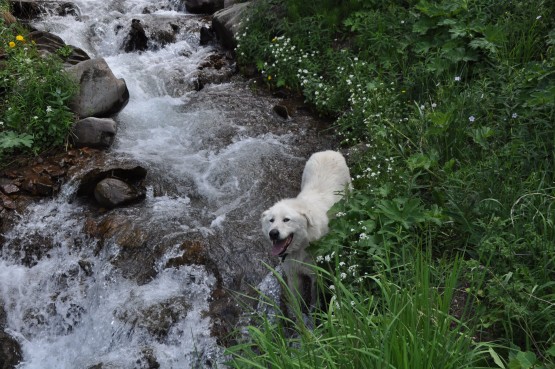
We had come to a comparatively level section of trail, so we assumed that we were nearing the top. We allowed the horses graze for a while, gave Bear a breather, and walked the kinks out of our legs. The late afternoon was growing warm, and fearing the typical afternoon thunderstorms, we decided to head back to camp. We were torn between desiring to see the view from the top and not desiring to slide down several thousand feet of slippery road if it should rain. With age comes wisdom, they say, so again we made the less adventurous choice.

Photo courtesy of Sangres.com.
In writing this narrative, I became curious about the elevation of Mount Maxwell, so I checked the internet. In addition to discovering that we probably must have climbed close to three thousand feet, I found pictures of the summit. It was a good thing that we turned back when we did, because probably just around a few more switchbacks, we would have had to turn back anyway! No way would we have attempted to ride that trail to the summit for ANY kind of view.
After we returned to camp, we decided not to spend another night at the campground because there were no other trails to explore, so we loaded up and headed home, arriving about dusk. The weary horses were thankful to sleep in their own “beds,” I was relieved not to have to worry through the night about their safety, and Bear was content to curl up in the hay. My husband commented, “Next time, we need to pack the hot tub.”
Although our camping trip was not what we had anticipated, we did have an enjoyable two days, and it made for a good story. The preparation should be much easier next time. It was a great practice run, and we are ready to try it again!
